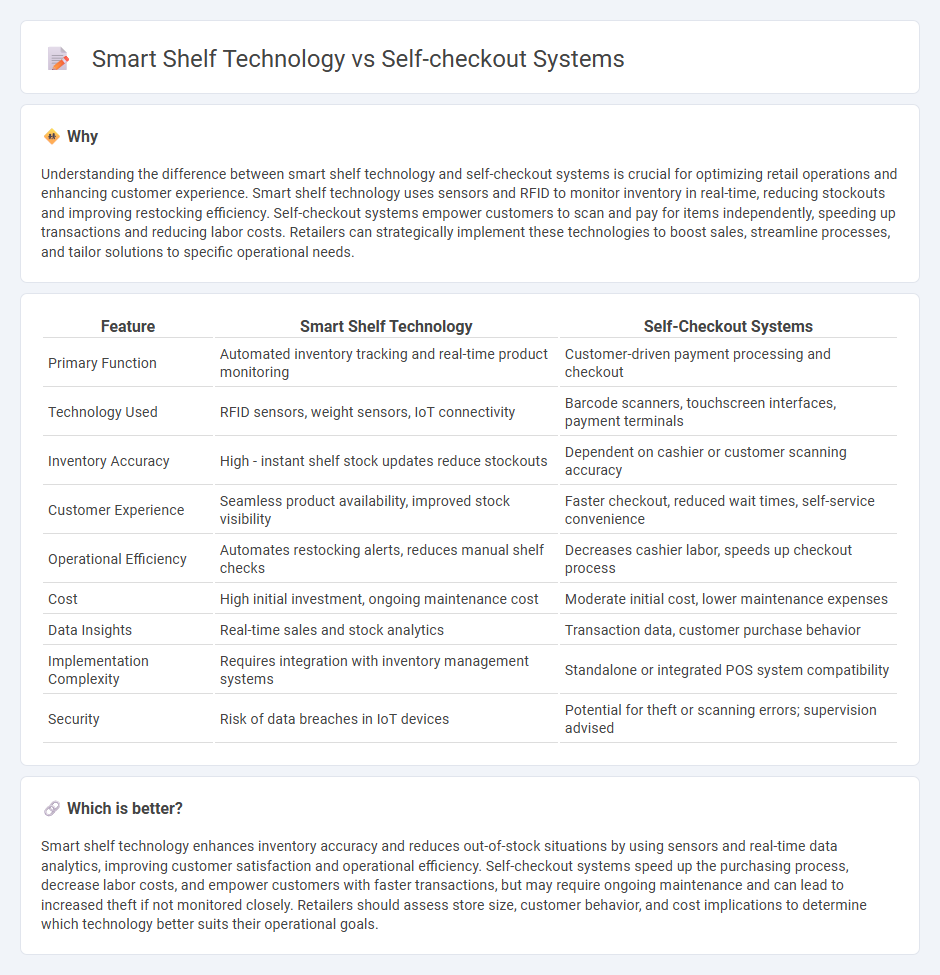
Smart shelf technology enhances inventory accuracy and customer experience by using sensors and RFID to monitor product availability in real-time. Self-checkout systems improve transaction speed and reduce labor costs by enabling shoppers to scan and pay for items independently. Explore how these innovations are transforming modern retail environments.
Why it is important
Understanding the difference between smart shelf technology and self-checkout systems is crucial for optimizing retail operations and enhancing customer experience. Smart shelf technology uses sensors and RFID to monitor inventory in real-time, reducing stockouts and improving restocking efficiency. Self-checkout systems empower customers to scan and pay for items independently, speeding up transactions and reducing labor costs. Retailers can strategically implement these technologies to boost sales, streamline processes, and tailor solutions to specific operational needs.
Comparison Table
| Feature | Smart Shelf Technology | Self-Checkout Systems |
|---|---|---|
| Primary Function | Automated inventory tracking and real-time product monitoring | Customer-driven payment processing and checkout |
| Technology Used | RFID sensors, weight sensors, IoT connectivity | Barcode scanners, touchscreen interfaces, payment terminals |
| Inventory Accuracy | High - instant shelf stock updates reduce stockouts | Dependent on cashier or customer scanning accuracy |
| Customer Experience | Seamless product availability, improved stock visibility | Faster checkout, reduced wait times, self-service convenience |
| Operational Efficiency | Automates restocking alerts, reduces manual shelf checks | Decreases cashier labor, speeds up checkout process |
| Cost | High initial investment, ongoing maintenance cost | Moderate initial cost, lower maintenance expenses |
| Data Insights | Real-time sales and stock analytics | Transaction data, customer purchase behavior |
| Implementation Complexity | Requires integration with inventory management systems | Standalone or integrated POS system compatibility |
| Security | Risk of data breaches in IoT devices | Potential for theft or scanning errors; supervision advised |
Which is better?
Smart shelf technology enhances inventory accuracy and reduces out-of-stock situations by using sensors and real-time data analytics, improving customer satisfaction and operational efficiency. Self-checkout systems speed up the purchasing process, decrease labor costs, and empower customers with faster transactions, but may require ongoing maintenance and can lead to increased theft if not monitored closely. Retailers should assess store size, customer behavior, and cost implications to determine which technology better suits their operational goals.
Connection
Smart shelf technology and self-checkout systems are connected through real-time inventory management and streamlined customer experiences. Smart shelves use RFID and weight sensors to track product availability and send data to self-checkout terminals, enabling automatic item recognition and faster transactions. This integration reduces checkout times, minimizes human error, and enhances overall retail efficiency.
Key Terms
Automation
Self-checkout systems automate the payment process by allowing customers to scan and pay for items independently, reducing labor costs and checkout times in retail environments. Smart shelf technology enhances automation by using sensors, RFID, and IoT connectivity to monitor inventory in real-time, streamline stock management, and improve customer experience through instant product information. Explore the latest innovations in retail automation to understand how these technologies optimize operational efficiency.
Inventory Management
Self-checkout systems streamline the purchasing process by allowing customers to scan and pay for items independently, reducing labor costs and enhancing transaction speed while maintaining real-time inventory updates through integrated POS systems. Smart shelf technology employs weight sensors, RFID tags, and smart cameras to monitor stock levels continuously, enabling precise inventory tracking and automated restocking alerts that minimize out-of-stock scenarios. Discover how integrating these technologies can revolutionize inventory management and improve retail efficiency.
Customer Experience
Self-checkout systems streamline the purchasing process by reducing wait times and enhancing convenience, while smart shelf technology improves inventory accuracy and provides real-time product information, directly impacting customer satisfaction. Both technologies leverage advanced data analytics and IoT integration to create a seamless, personalized shopping environment that boosts operational efficiency and consumer engagement. Explore how combining these innovations can transform retail experiences and elevate customer loyalty.
Source and External Links
9 Steps To Implement Self Checkout For A Small Business - Self-checkout systems enable customers to process purchases independently in retail stores via kiosks, handheld scanners, app-based scanning, or RFID readers, aiming to improve convenience, reduce wait times, and lower labor costs.
Self-checkout - Wikipedia - Self-checkout machines allow customers to scan and pay for items without staff assistance; widely used in supermarkets since the 1980s, with a rapidly growing global deployment expected to reach 1.2 million units by 2025.
Self-Checkout Pros and Cons - Wavetec - These systems improve shopping convenience by reducing queues and allowing versatile payment options such as cash, cards, and mobile payments, thus enhancing the efficiency of the checkout experience.
 dowidth.com
dowidth.com